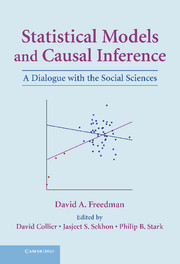Book contents
- Frontmatter
- Contents
- Preface
- Editors' Introduction: Inference and Shoe Leather
- Part I Statistical Modeling: Foundations and Limitations
- Part II Studies in Political Science, Public Policy, and Epidemiology
- 4 Methods for Census 2000 and Statistical Adjustments
- 5 On “Solutions” to the Ecological Inference Problem
- 6 Rejoinder to King
- 7 Black Ravens, White Shoes, and Case Selection: Inference with Categorical Variables
- 8 What is the Chance of an Earthquake?
- 9 Salt and Blood Pressure: Conventional Wisdom Reconsidered
- 10 The Swine Flu Vaccine and Guillain-Barré Syndrome: A Case Study in Relative Risk and Specific Causation
- 11 Survival Analysis: An Epidemiological Hazard?
- Part III New Developments: Progress or Regress?
- Part IV Shoe Leather Revisited
- References and Further Reading
- Index
8 - What is the Chance of an Earthquake?
Published online by Cambridge University Press: 05 June 2012
- Frontmatter
- Contents
- Preface
- Editors' Introduction: Inference and Shoe Leather
- Part I Statistical Modeling: Foundations and Limitations
- Part II Studies in Political Science, Public Policy, and Epidemiology
- 4 Methods for Census 2000 and Statistical Adjustments
- 5 On “Solutions” to the Ecological Inference Problem
- 6 Rejoinder to King
- 7 Black Ravens, White Shoes, and Case Selection: Inference with Categorical Variables
- 8 What is the Chance of an Earthquake?
- 9 Salt and Blood Pressure: Conventional Wisdom Reconsidered
- 10 The Swine Flu Vaccine and Guillain-Barré Syndrome: A Case Study in Relative Risk and Specific Causation
- 11 Survival Analysis: An Epidemiological Hazard?
- Part III New Developments: Progress or Regress?
- Part IV Shoe Leather Revisited
- References and Further Reading
- Index
Summary
Abstract. Making sense of earthquake forecasts is surprisingly difficult. In part, this is because the forecasts are based on a complicated mixture of geological maps, rules of thumb, expert opinion, physical models, stochastic models, and numerical simulations, as well as geodetic, seismic, and paleoseismic data. Even the concept of probability is hard to define in this context. For instance, the U.S. Geological Survey developed a probability model according to which the chance of an earthquake of magnitude 6.7 or greater before the year 2030 in the San Francisco Bay Area is 0.7 ± 0.1. How is that to be understood? Standard interpretations of probability cannot be applied. Despite their careful work, the USGS probability estimate is shaky, as is the uncertainty estimate.
Introduction
What is the chance that an earthquake of magnitude 6.7 or greater will occur before the year 2030 in the San Francisco Bay Area? The U.S. Geological Survey estimated the chance to be 0.7 ± 0.1 (USGS, 1999). In this chapter, we try to interpret such probabilities.
Making sense of earthquake forecasts is surprisingly difficult. In part, this is because the forecasts are based on a complicated mixture of geological maps, rules of thumb, expert opinion, physical models, stochastic models, numerical simulations, as well as geodetic, seismic, and paleoseismic data.
- Type
- Chapter
- Information
- Statistical Models and Causal InferenceA Dialogue with the Social Sciences, pp. 115 - 130Publisher: Cambridge University PressPrint publication year: 2009
- 1
- Cited by



